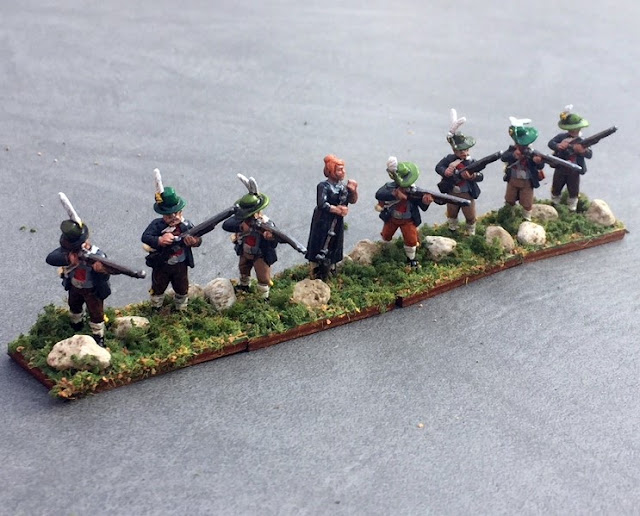The last of the Tirolese Schutzen units, this one is lead by Herr Friedrich Ursprung.
Friedrich's men and women wear dark grey coats, pants in shades of brown, and hats in shades of green.
Concluding our narrative by Charles Morris:
Of the two other principal leaders of the Tyrolese, Haspinger, the Capuchin, escaped to Vienna, which Speckbacher also succeeded in reaching, after a series of perils and escapes which are well worth relating.
After the dispersal of his troops he, like Hofer, sought concealment in the mountains where the Bavarians sought for him in troops, vowing to "cut his skin into boot-straps if they caught him." He attempted to follow the mountain paths to Austria, but at Dux found the roads so blocked with snow that further progress was impossible. Here the Bavarians came upon his track and attacked the house in which he had taken refuge. He escaped by leaping from its roof, but was wounded in doing so.
For the twenty-seven days that followed he roamed through the snowy mountain forests, in danger of death both from cold and starvation. Once for four days together he did not taste food. At the end of this time he found shelter in a hut at Bolderberg, where by chance he found his wife and children, who had sought the same asylum.
His bitterly persistent foes left him not long in safety here. They learned his place of retreat, and pursued him, his presence of mind alone saving him from capture. Seeing them approach, he took a sledge upon his shoulders, and walked towards and past them as though he were a servant of the house.
His next place of refuge was in a cave on the Gemshaken, in which he remained until the opening of spring, when he had the ill-fortune to be carried by a snow-slide a mile and a half into the valley. It was impossible to return. He crept from the snow, but found that one of his legs was dislocated. The utmost he could do, and that with agonizing pain, was to drag himself to a neighboring hut. Here were two men, who carried him to his own house at Rinn.
Bavarians were quartered in the house, and the only place of refuge open to him was the cow-shed, where his faithful servant Zoppel dug for him a hole beneath the bed of one of the cows, and daily supplied him with food. His wife had returned to the house, but the danger of discovery was so great that even she was not told of his propinquity.
For seven weeks he remained thus half buried in the cow-shed, gradually recovering his strength. At the end of that time he rose, bade adieu to his wife, who now first learned of his presence, and again betook himself to the high paths of the mountains, from which the sun of May had freed the snow. He reached Vienna without further trouble.
Here the brave patriot received no thanks for his services. Even a small estate he had purchased with the remains of his property he was forced to relinquish, not being able to complete the purchase. He would have been reduced to beggary but for Hofer's son, who had received a fine estate from the emperor, and who engaged him as his steward. Thus ended the active career of the ablest leader in the Tyrolean war.
Big Dogs, Little dogs!




















































